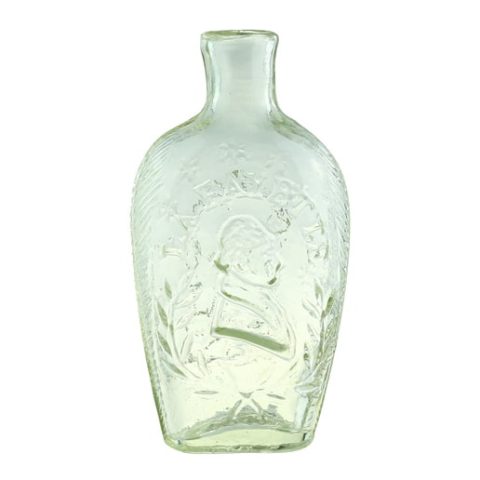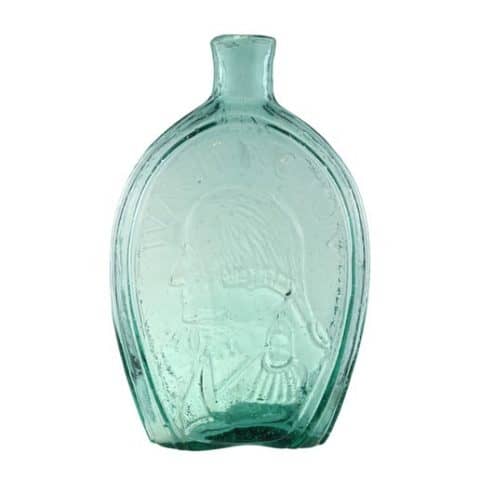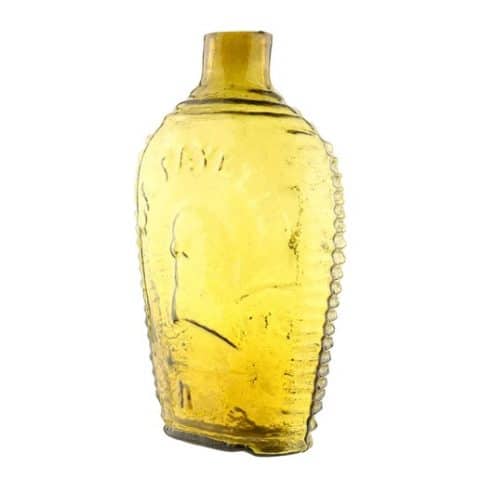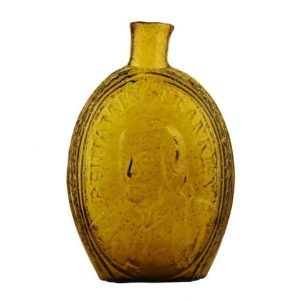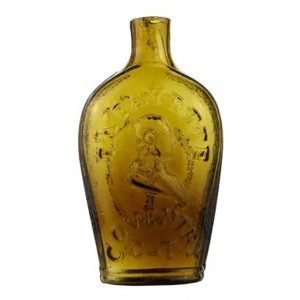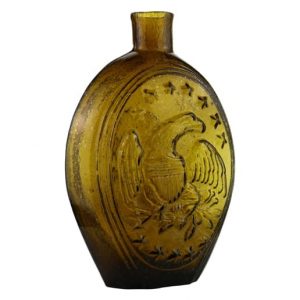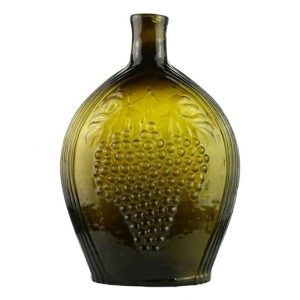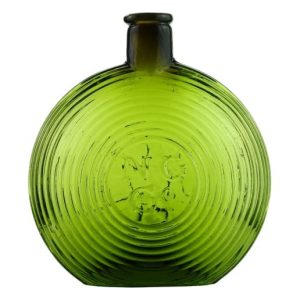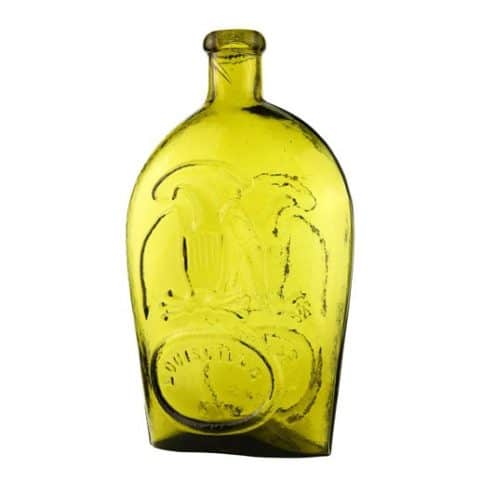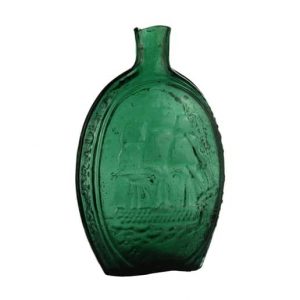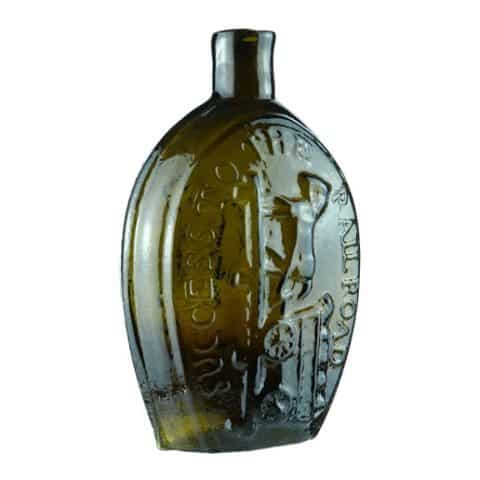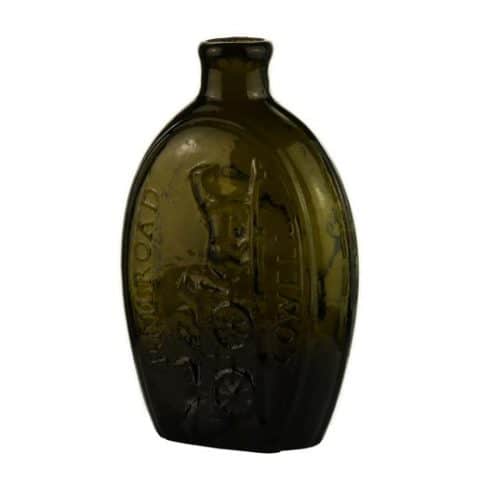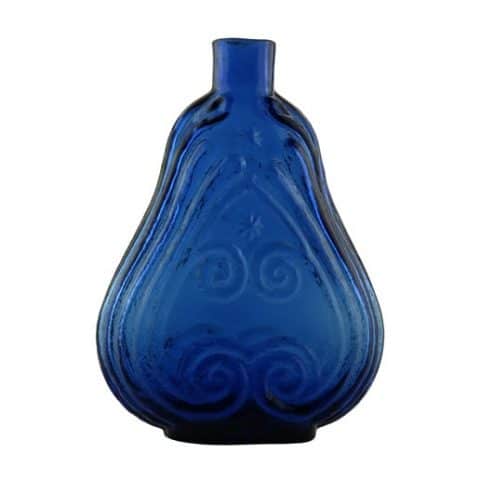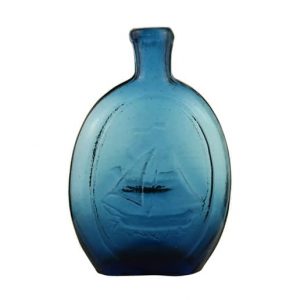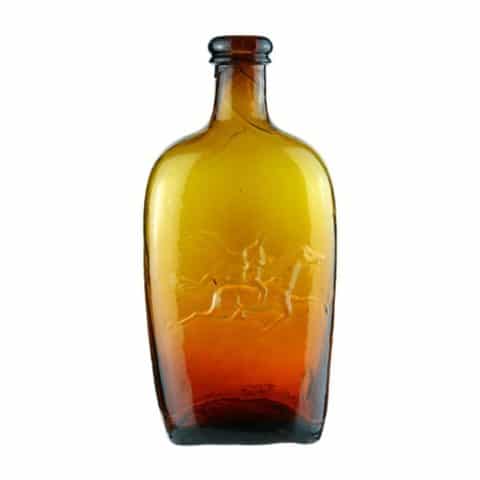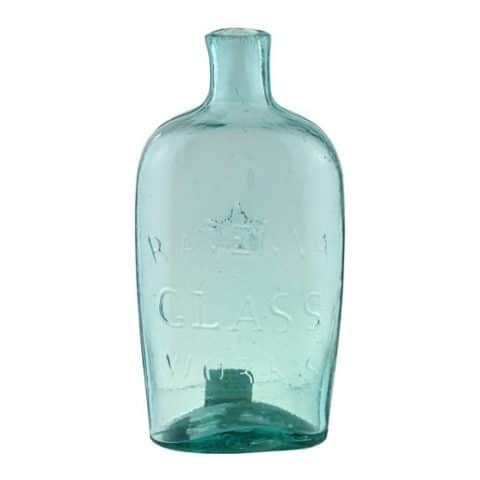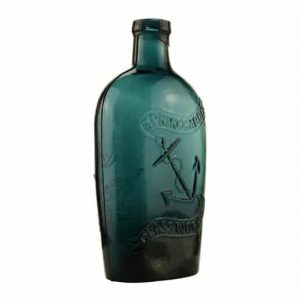GIX-42 “J R. & S” Scroll Flask
GIX – 42
“J R. & S” Scroll Flask
John Robinson & Son, Pittsburgh, Pennsylvania
Yellow Green Half Pint
Provenance: Anonymous

One of the most beautiful, eye-appealing, and collectible historical bottles is the scroll flask which is easy to spot with its distinctive curved form and design. The bottles come in your typical flask sizes and in many colors and patterns. Many of them tell a story. While aqua is the most common color, by far, other brilliant colors (greens, yellows, ambers, and blues) are not infrequently encountered and fetch top dollar by collectors.
George and Helen McKearin described the scroll (or violin) flasks in their book, American Glass, in the 1940s with details on 51 different molds. This list was later expanded with many variants in American Bottles and Flasks and Their Ancestry. Often, the difference between molds for scroll flasks comes down to the precise placement and shape of embossed stars and other details.
Our museum example of a yellow-green half-pint “J R. & S scroll flask” has two ribs flanking the pear-shaped frame. On what is considered the primary face of the flask is a scrolled framing that is enclosing a large embossed anchor. Two pearls are above and below each fluke of the anchor.

The reverse of the scroll flask has the same ribbing and scroll framing but with a fleur-de-lis in the upper portion of the frame. Two pearls are located just below and to the extreme right and left of the fleur-de-lis. A medium embossed ‘J R. & S’ is placed in an arc between the pearls and scrolls.
This half-pint scroll has a plain lip and a base that is described as a plump oval. It also has a pontil mark and a vertical medial rib.
You can find the GIX-42 scroll flask in aqua, yellow-green, citron, gold amber, clear, and light lavender glass which are very rare, and dark amethyst which is considered extremely rare. The dark amethyst example (pictured further above) was from the 1983 Blaske Auction and is on display in the museum.
The J R. & S scroll flask was produced at John Robinson and Son, Pittsburgh, Pennsylvania from 1830 to 1834. John Robinson opened the Stourbridge Flint Glass Works at Pittsburgh in 1823. The plant’s primary products were various types of flint tableware as well as pressed doorknobs. The factory also made flasks. Robinson’s son, Thomas, entered the company sometime around 1830, affecting a name change to John Robinson & Son. The plant made three different scroll flasks, two marked with “JR&S,” the other with “JR&SON.”

Primary Image: J R. & S scroll flask imaged on location by the FOHBC Virtual Museum midwest studio led by Alan DeMaison.
Support: Reference to Cheers to the Privy by Jeff Mahalik, Bottles and Extras, September-October 2017
Support Images: Auction Lot 158: “JR. & S” Scroll Flask, John Robinson and Son Manufacturers, Pittsburgh, Pennsylvania, 1830-1834. Aquamarine, sheared mouth – pontil scar, half pint; (light exterior high point wear). GIX-42 Strong mold impression and an interesting yellow-olive striation. Fine condition. – Norman C. Heckler & Company, Auction #164
Support Images: “J R & Son” SCROLL FLASK, John Robinson & Son Glass Manufacturers, Pittsburgh, PA, 1830–1834. Beautiful medium amethyst in the shoulders shading to clear, pale amethyst in the lower scroll and foot area, with profuse striations through the center and lower portion of the flask, sheared mouth – blowpipe pontil scar, Pt; (a shallow, approx. ¼” wide, pontil flake that extends to the edge of the base, and some high point wear). GIX-43. An exceptional flask, exceptional color, and eye-appeal. This flask is an exciting, and significant, “fresh” discovery for the antique bottle world. Quoting Jay Hawkins, a well-known scholar of Pittsburgh glass and glass manufacturers, and author of the 2009, 550-plus page book, Glasshouses & Glass Manufacturers of the Pittsburgh Region, 1795–1910, “At this year’s Baltimore Bottle show on March 8th I had the opportunity to view and hold what is arguably the quintessential bottle or flask produced in Pittsburgh.” The flask is one of only four, or possibly five examples known. Of the four confirmed examples, three are in museum collections, the fourth, and only confirmed privately held example, is the Ex. Fred Salisbury, Ex. George Austin example, with damage. The museum examples include: The Corning Museum of Glass (a very deep amethyst coloration), The Metropolitan Museum of Art in NYC (another dark example), and a lavender example that was in the renowned George Lorimer collection, bequeathed to the Philadelphia Museum of Art in 1938. – John Pastor, American Glass Gallery, Auction #14

Support: Reference to American Bottles and Flasks and Their Ancestry by Helen McKearin and Kenneth M. Wilson, Crown Publishers Inc., New York, 1978.
Support Images: Auction Lot 40: “J.R. & Son” Scroll Flask, John Robinson and Son Manufacturers, Pittsburgh, Pennsylvania, 1830-1834. Deep amethyst, tooled mouth – pontil scar, half pint; (1/2 inch by 3/4 inch area of the mouth has epoxy repair, 1 inch crack at the repair, open bubble on edge of frame). GIX-42 Extremely rare. Beautiful color. Unique. Ex Edmund & Jayne Blaske collection, #841. – Norman Heckler, Norman C. Heckler & Company
Support Images: Auction Lot 146: “JR. & S” Scroll Flask, John Robinson and Son Manufacturers, Pittsburgh, Pennsylvania, 1830-1834. Brilliant medium yellow-green, tooled mouth – pontil scar, half pint; (3/16 inch cooling fissure in neck, just a hint of exterior high point wear). GIX-42 Wonderful exterior surface and strong mold impression. Amazing bright color. Generally fine condition. Dr. Gary and Arlette Johnson collection. – Norman Heckler, Norman C. Heckler & Company
Join the FOHBC: The Virtual Museum is a project of the Federation of Historical Bottle Collectors (FOHBC). To become a member.














